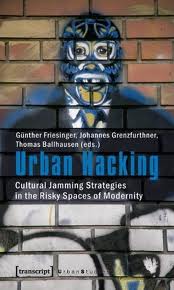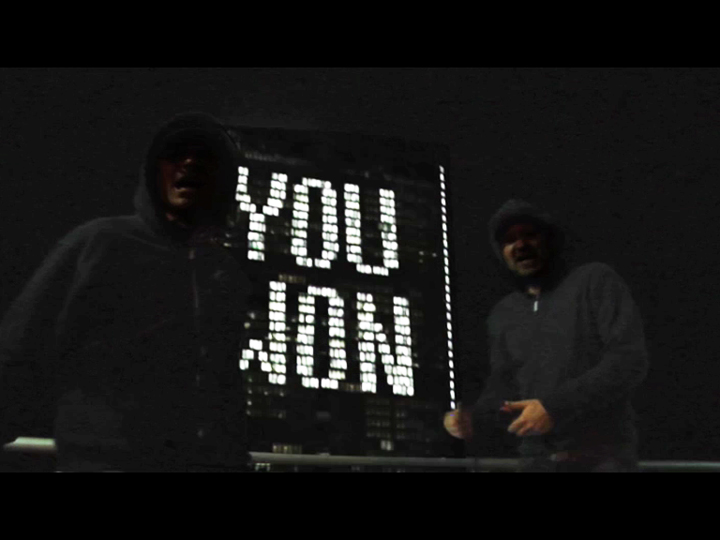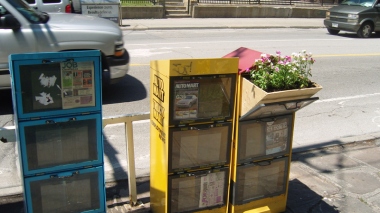Urban Hacking:
Culture Jamming in the Risky Spaces of Modernity
Book Review
24 Sep 2011

"Urban spaces have become battlefields, signifiers have been invaded, new structures have been established: Netculture replaced counterculture in most parts and also focused on the everchanging environments of the modern city. Important questions have been brought up to date and reasked, taking currrent positions and discourses in to account. The major question still remains, namely how to create culturally based resistence under the influence of capatilistic pressure and conservative politics."
This statement encapsulates the key arguments put forth in a remarkable collection of essays. Culled from the 2009 paraflows festival in Vienna, the collection includes work from artists across North America and Europe. Having just finished my dissertation, which looked at the positioning of an urbanism grounded in public computing and experimental culture, I found a wealth of ideas to savor in this volume. Firstly, how does 'urban', a word about the physical city, and 'hacking' a tradition in the digital culture come together as an idea, without feeding some grisly scene?
For many, 'neo-liberal' urban space daily infringes upon what we envision as a better city, society, and world. Growth of the 'neo-liberal city' is to be fought against by artists and planners; pushed back with its rising tsunami of commercialism, land grabs, and gentrification. According to this insightful book, a starting point for resistance must happen in an active intellectual critique of certain "left liberal" arguments and from the development of a new field of operations.

For an example, one issue, close to my heart, is research and writing on urban landforms and riverways and the attendant cultures which have evolved from their daily use, contact with, and memory. These writings emerge today from thinkers who perceive the slow erosion of inhabitation of such places, as a direct result of neo liberal capital. A favorite essay of mine, not in this book, but which articulates the problem precisely, is about Paris and the Seine, and the famed river's waterfront renovation under notorious master planner Hausmann. He transformed the banks of the Seine from a place for working people to mingle whilst laundering clothing, relaxing,and bathing, into a pastoral element which engaged new urban classes in notions of "the promenade". Under Hausmann's clean up schemes, a long treasured urban phenomenon of place, was lost. Such was nineteenth century development and gentrification of the Parisienne riverfront.
In San Francisco, history projects such as Chris Carlsson's urban history bike tours, and talks at the Randall Art Museum, as well as the work of archivist/historian Greg Gaar (Other Cinema program Spring 2011) chronicle environmental changes to water resources in the city. The disappearance and recuperation of our city's aquifers, lakes, ponds, and other ecologies, is presented as an epi-phenomenon of conflicted value systems between capital planning and citizen/animal land use. Loss of these precious resources, as well as the flora and fauna, and sense of experience and public usage with them, is the "paving of paradise" as singer Joni Mitchell once lamented so perfectly.
Come to think of it Piranesi's "Rome" can be construed today as an urban hack about 18th century precarity.His art and architectural space described oppressive 'carceri' of the imagincation, tumbling down.
The 'neo-liberal city' is now the gentrifying city of the late eighties and nineties under a new umbrella trend of economics and political life. Gentrification, or the deliberate forcing out of tenants as a result of payoffs and rent hikes, in order to install a new economic, often race-based order into the urban fabric, takes place superficially within marketable, softer narratives of trend, style, and crime-prevention. It appeals, thus, to the acquired tastes of a middle ground of communities buying into "engagement". Whatever the exact terminology we want to label this fraudulent apparatus, doesn't really matter. The fact that old processes, however, including gentrification, cultural colonization, and commercialization appear to have transformed with a new face of quasi-political "community" development, does. In these new conglomerates, cross-pollinating "stakeholders" diversify the base order of Things and Desire into palatable "value chains" of 21st century markets and are bolstered from within by "niche" marketing, gps navigational tools, and market research. Come to think of it, Piranesi's "Rome" could be construed today as an urban hack about 18th century precarity. His art and architectural space described the walls of oppressive 'edifici' tumbling down. So, regarding the book, its beauty is critique; critique of public space as we have known it and critique of its disappearance. The texts probe the idea of public space, not only as a built form, but also as a discursive system, hence the link to hacking, both of which are created under bourgieous capital. What is its real function, then, and how do we resist the reconstitution of these values?

Frederick Law Olmsted, the American landscape architect, I learned, in a brief conversation with author Mike Davis at the end of his talk on Ecology of Fear at the now defunct and disappeared New College of California, where I use to teach video production, conceived of Central Park, in design as a place to placate the tired, cramped working class. Olmsted envisioned his new park as giving this population, potentially unruly, somewhere to respite from the city. A grand Central Park would aid, ultimately, in the making of a calm proletariat. But, the basic problem of this idea and its conscious/unconscious mimicry in newer urban agendas, is that "the public", "the proletariat" and "the working class" is an imagined and invisible concept.
The 'neo-liberal city' today, and artistic response to it, has been driven by this imaginary and the reified 'placelessness' which problematizes security for those not vaulted into a fortress. (Davis) The question has become, then, what is the space for radical art (Slater and Iles) and how can our communities hold on?
Through the twin approaches, Guerrilla Art and Hacking, editors assert the nexus of digital/virtual and physical as the transitional space from which resistance emerges. If the Situationist International and Ant Farm had had the internet, one can only wonder how they would have used it to challenge the ennui of spectacular space.
Urban Hacking, as a book, tracks numerous strategies, including Augmented Reality interventions, billboard alteration, graffiti, tags, and greening, as a kind of "programmable literature", made possible through open sourcing of code and the artistic re-use of place. From this admixture, we have the foundations of an urbanism made by and for "the people" which, at the same time as interrogating the fabric of spaces overtaken, outsourced, managed and mined, hales radical, digital cultures, and opens surfaces for dialogue with urban environments from within a post-colonial critique. The book is an attempt, I would argue, to identify strategies for the problem spaces which might be creatively detourned, delimited, or re-designed. It articulates the problem of politicized urban art as requiring a much-needed re-invention of itself, on toothier terms.
But, the book is, also, self-consciously, historical. There is a chapter on Lenin's vision for the center of Lviv, for instance, which shows how he re-engineered the monuments and central squares of that city. The aforementioned central question or "problem" is edited through the lens of Guerrilla Art, critiquing the term 'guerrilla', in the first section, and discussing interference in these spatial systems via Hacking and the digital culture, in the second half of the book. In the latter section, new cities such as the "P2PFOUND City" proposal, the "Urban Trash Zone", "Fell: Feral City" and others are considered by Cityleft and the P2P Foundation, Kersten Ohler, Verena-Cathrin Bauer, and others. Through the twin approaches, Guerrilla Art and Hacking, editors assert the nexus of digital/virtual and physical as a transitional space wherein lies resistance. One can only wonder how the Situationist International and Ant Farm, to name two groups, would have used the Internet, code, and the Web against spectacular space.

Urban Hacking attacks the problem of urban public space, cutting through present concepts and re-design of cities, with its rejection of neo liberal thought. Half the world's population now lives in urban areas and that number is a conservative figure, expected to grow exponentially in the next decades. Seattle based writer, a contributor to the book, Eleanor Siatta writes about the potential for political change:
"The city exists in conversation, writing, image, and music, all of which shape the shared imaginary...Change the imaginary and you change the city."
The editors write:
"Urban Hacking signifies strategies that do not talk 'about' the public space, but rather 'through it', in it. and with it, through its disruption, interruption and opening (or: through disabling its mechanisms of closure)."
In this unveiling, by removal of the veil of capitalism and rejection of the brain as a "typical" screen, "they" live, and "we" can see.
Urban Hacking: Culture Jamming Strategies
in the Risky Spaces of Modernity
Gunther Friesinger, Johannes Grenzfurthner, Thomas Ballhausen, eds.
New Brunswick/London: Transaction Publishers, 2010, 230 pages
ISBN 978-3-8376-1536-4
Related Links and Works
URBAN HACKINGDavid Cox's Sign Wars
Scott Beale's post on the book URBAN HACKING
No Room to Move: Radical Art and the Regenerate City anthology, edited by Josephine Slater and Anthony Iles, 2011
MUTE magazine panel audio file:"No Room to Move" *Molly Hankwitz received her Ph.D, in Spring 2011, in media and communications from one of Australia's leading universities, Queensland University of Technology. Her dissertation, on 'personal media and wireless cities', is an emerging critique and analysis of portable media use and development in cities. She is an architect-by-training, living in San Francisco.